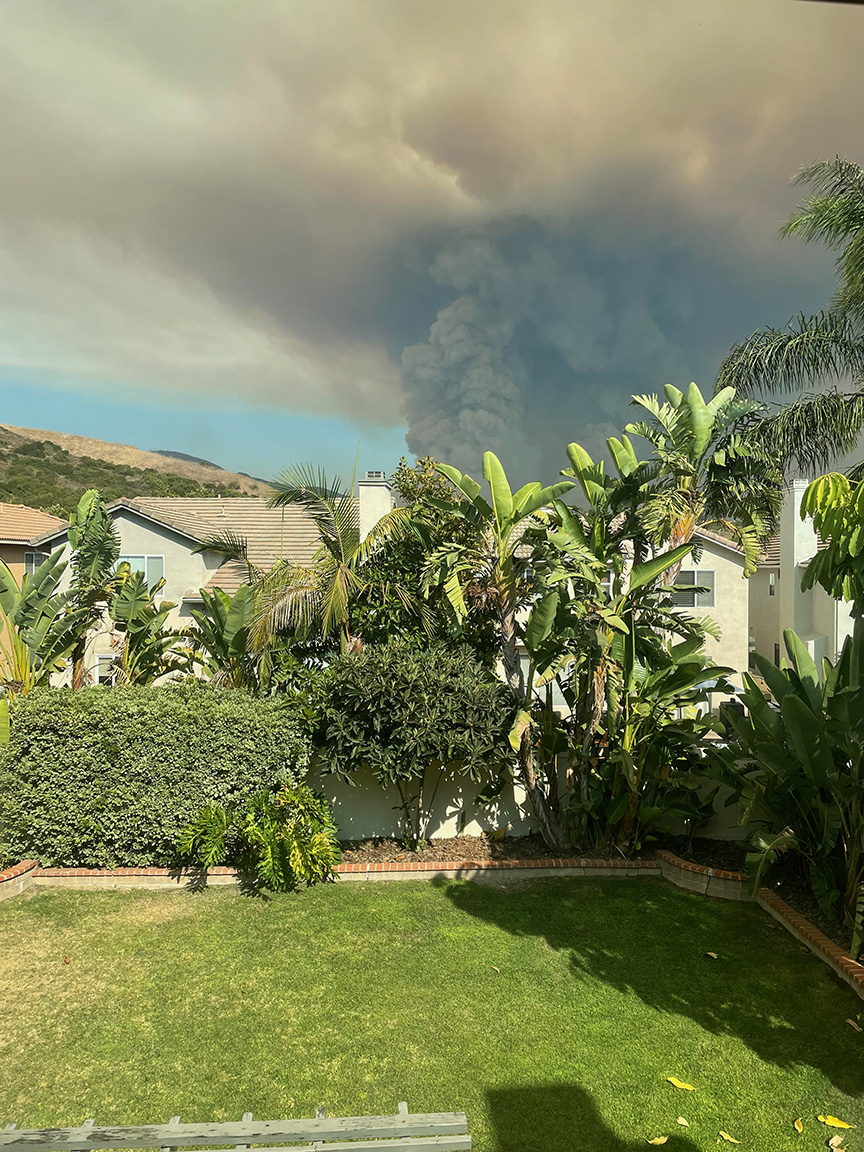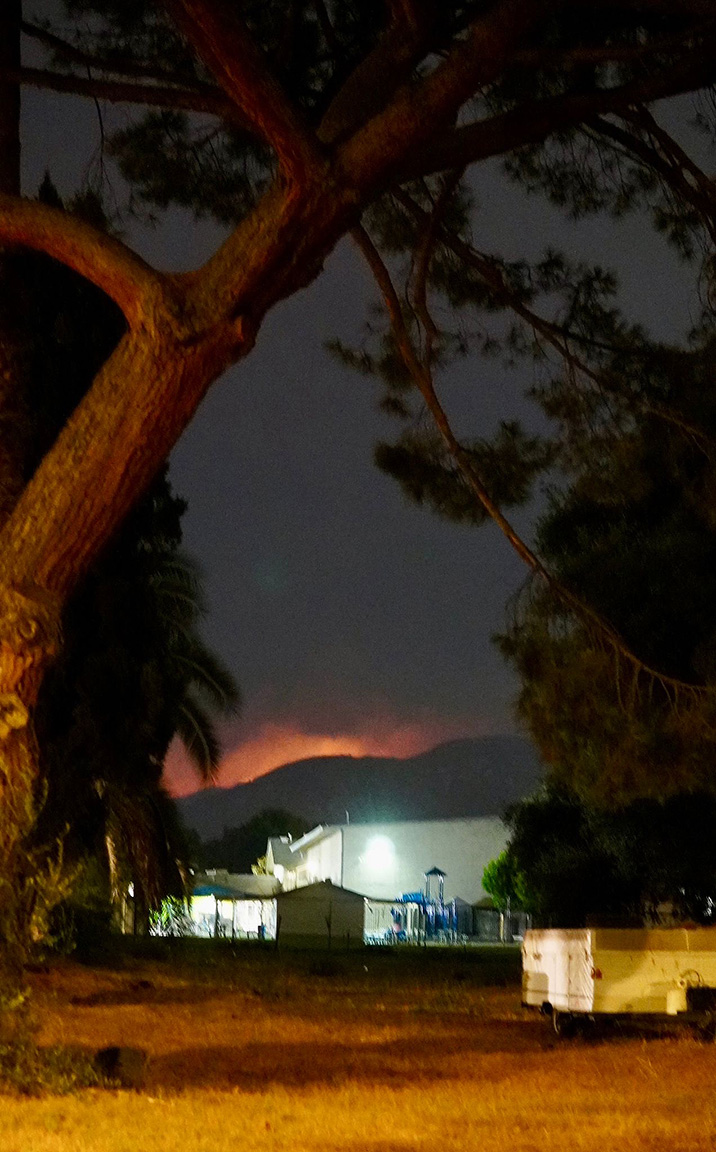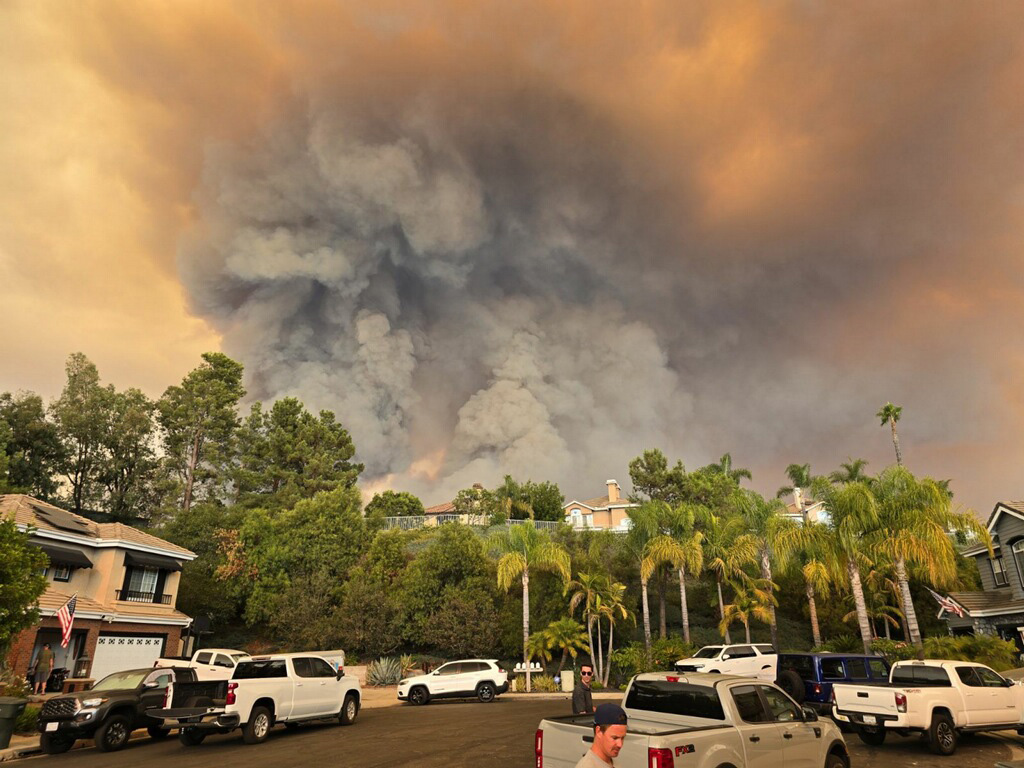
The Airport Fire burns on a ridge near Trabuco Canyon. Photo: Paul Hinson
[The Episcopal News – September 11, 2024] St. John’s church and school community swiftly mobilized as the Airport Fire escalated Sept. 10 in Rancho Santa Margarita in Orange County, offering aid and housing evacuees.
For Sheryll Grogan, acting head of school, the safety of school administration, faculty and staff was uppermost in her decision to close the campus for Tuesday.
“It is scary, but as a community we’ve come together. I took in a teacher and her two dogs, who was forced to evacuate,” Grogan, a 33-year church member who also is housing an evacuee, told The Episcopal News in a telephone interview. “Actually, our church community has posted a spreadsheet of people who have places they can offer and then people who need places can respond accordingly.”

Smoke billows from the Airport Fire in South Orange County, pictured from Foothill Ranch, near Rancho Santa Margarita. Photo: Raquel Pettersen
The campus remained closed Sept. 11, but did not appear to be in immediate danger as the blaze exploded from Orange to Riverside counties overnight, burning homes in Lake Elsinore and destroying more than 20,000 acres with zero percent containment by late Tuesday.
The Orange County Fire Authority named it the Airport Fire after a spark ignited from heavy equipment around 1 p.m. Monday near a remote-controlled airplane airport on Trabuco Creek Road. It is one of three fires burning in and around the Diocese of Los Angeles, exacerbated by a scorching heat wave and desert winds. At least 13 people, including residents and first responders, have been injured, the L.A. Times reported.
The Line Fire in San Bernardino County began Sept. 6 in the city of Highland and had burned at least 34,000 acres and destroyed at least one home with about 14% containment by Tuesday. News outlets reported that a 34-year-old Norco man has been arrested on suspicion of starting the fire, which began in the area of Base Line Road and Alpin Street and burned through the San Bernardino Mountains, edging closer to Big Bear.
Longstanding interfaith friendships came into play Saturday when leaders of NewGround – “a Jewish-Muslim Partnership for Change” – phoned managers at St. Paul’s Commons, the diocesan headquarters and retreat center, with word that NewGround high-schoolers meeting in retreat in the San Bernardino mountains had received an order to evacuate.
Within 30 minutes, Canon Anilin Collado, diocesan retreat center manager, had provisions in place to welcome the 22 retreatants and four counselors in double-occupancy rooms, with meeting space, in the Echo Park facility. With support of the retreat center team assisted by Canon for Common Life Bob Williams, a warm welcome was provided, and the retreat program continued, documented by a CBS News team.
“We feel like we are coming home,” said NewGround staffer Tasneem Noor, who is also one of four interfaith ministers-in-residence in the Episcopal Diocese of Los Angeles, said on arrival. Noor frequently conducts conferences at St. Paul’s Commons, which is also home to the Nefesh Jewish Community and its weekend Shabbat services. Several parents of the retreatants spread the word that all would be safe and productive at St. Paul’s Commons.
In Big Bear, Alan Herendich, a lay leader at St. Columba’s Spirit of Peace Church, an Episcopal and Lutheran congregation, told The News that although many people were leaving the area, he had no immediate plans to heed a voluntary evacuation order.
“There are only three routes in and out of Big Bear and two of them are closed because of the fire,” he said. “With over 20,000 people living up here and only one road to get out,” officials might order evacuations out of an abundance of caution.
“There are many people who own horses up here. They have to trailer them and get them down the hill and that one road is a pretty gnarly one. Things like that make it difficult.”
Herendich, a hospice volunteer and a school bus driver, said he might be called upon to transport patients and residents from the area in school buses. “If people need to get down the hill and don’t have means to do it, we could be called upon to drive them down in school buses. Authorities are scrambling to be sure we are prepared in case the need arises,” he said.
Since the church is in the evacuation zone, he doubted it could serve as an alternate community space for evacuees, but it did not appear to be in any immediate danger, he said.
Schools and other entities have closed, and heavy smoke blanketing the area has created poor air quality, “and there is quite a bit of ash fall,” he said.
As a 37-year Big Bear resident, he said he feels like a fire season veteran and has a “go bag” assembled if a quick getaway becomes necessary. But he is resisting leaving. “There’ve been fires all around this area at one time or another,” he said. “I’m on the east end of the lake. Given my location, I’m going to have to see the fire get a whole lot closer before I take off.”

The Bridge Fire nears the crest of a hill north of La Verne on Sept. 9. Flames receded the next day as the wind blew the fire towards Mt. Baldy (Mount San Antonio) and Wrightwood. Photo: Wayne Kawamoto
Meanwhile, firefighters continued to battle a third area fire in the Los Angeles National Forest, known as the Bridge Fire, which by Tuesday had destroyed several homes, more than 34,000 acres and prompted evacuations in Wrightwood, and warnings for Mount Baldy, Upland, northern Claremont and other San Gabriel Mountain areas.
Kathy Walker, a parishioner at St. Mark’s Church in Upland who lives in Mt. Baldy Village, said the fire suddenly expanded, forcing a speedy evacuation. “We had been watching it through the foothills. The smoke was going the other way and, all of a sudden, it was there. Sometime between 3:30 and 4 p.m. that wind came up and it exploded. It went from about 4,000 acres to 40,000 in a heartbeat.
“The fire chief came down the street and said ‘It’s time to go, you’ve got maybe 15 minutes.” We had packed. We threw a few things in the car and as we were driving down the mountain, there was a huge tornado-like cloud churning above the ridge. I was so scared.”
Walker said the fire burned mostly along the north and west side of Mt Baldy Village. “It took out maybe four or five homes that were pretty high on the hill, and it came down in towards the creek a bit and then I don’t know what happened up above. And it went over the hill into Wrightwood, which is astounding.”
Staying at an AirBnB in Upland with other family members, she said several church members and other evacuees “were here last night for hugs and support” and that St. Mark’s was open for people to gather.
The fires forced road closures, power and internet outages and “we’ll be lucky if there’s any water left by the time we get back,” Walker said. “It’s gonna be a mess for a while. But so far I think everybody got out that needed to get out.
The Bridge Fire began Sunday in the San Gabriel Canyon area near East Fork Road by Cattle Canyon Bridge and by Tuesday had burned more than 46,000 acres with zero percent containment.
The Very Rev. Keith Yamamoto, rector of St. Mark’s, Upland, and dean of Deanery 6, said he was unaware of any church structures in the area threatened by the fire. Several St. Mark’s parishioners had been evacuated from Mount Baldy and others in Claremont and Upland were under evacuation warnings.
Paul Hinson, St. John’s bishop’s warden, told The News he was forced to evacuate from his Trabuco Canyon home Tuesday afternoon, and quickly discovered some local hotels were exploiting the crisis. “We had to pack up our cats, get a go bag together for them and get them into cages. It took us about an hour to get everything put together and to check on all our neighbors, and then we got out.”
“We didn’t want to take congregants up on their offers to house evacuees, but there are no hotels with availability … within thirty miles of Mission Viejo right now,” he said. “Some were offering rooms from $400 to $1,000 a night and that’s ridiculous.”
At least three other church families have been evacuated and all, including Hinson, are staying at the homes of other members, he said. “We are so thankful to St. John’s. We look after each other.”
Although concerned about the possibility of losing his home, he said: “It’s just objects. Sure, there are objects that can’t be replaced, but people can’t be replaced.”

Smoke from the Airport Fire rises above homes in Rancho Santa Margarita in South Orange County. Photo: Paul Hinson
Raquel Petterson, a Foothill Ranch resident who attends St. George’s Church in Laguna Hills, echoed the same sentiment. “I’ve been watching the flames over the ridge from my bedroom window, waiting to see if they jump the ridge,” she said. “We’ve never unpacked from the last time we were evacuated, in 2021.
“We have three storage boxes we’ll take and a few clothes. Whatever we leave behind, we can’t cry over it, if these things were to burn. We’re ready to again if we have to. We live in fire country.”
Authorities have said that scorching heat, desert winds and humidity have hampered the efforts of firefighters, which was also a concern for Grogan as she considered closing the St. John’s campus in Rancho Santa Margarita.
“Everyone understands it’s safety first, and staying out of the first responders’ way,” she said, adding that her staff has monitored the situation closely and been in touch with Bishop John Harvey Taylor, a former St. John’s vicar.
She closed the school on Tuesday because she was concerned that its 500 students, ages 2 to 14 from Irvine, Newport Beach and throughout South Orange County, might not have been able to get out of the area, or might add to congestion and hamper firefighter efforts.
Already, she added, efforts are underway to show appreciation for first responders, “to take some collections and make some cards to warm the hearts of firefighters,” she said. “They’re already being taken care of with food and expressions of kindness. As soon as we can, we want to place a banner on the main road, thanking them, and have all the children sign it. This idea just sprang up organically from one of our parents.
“Our hope is we’ll be back on Thursday and that the air quality will be improved.”
